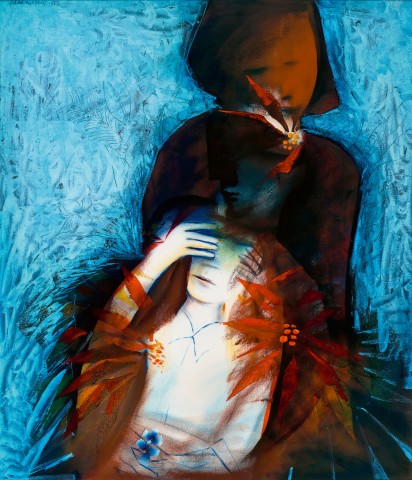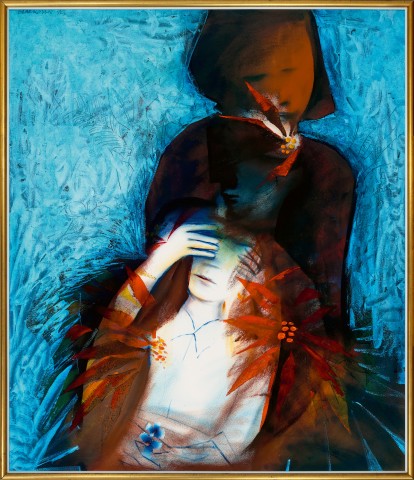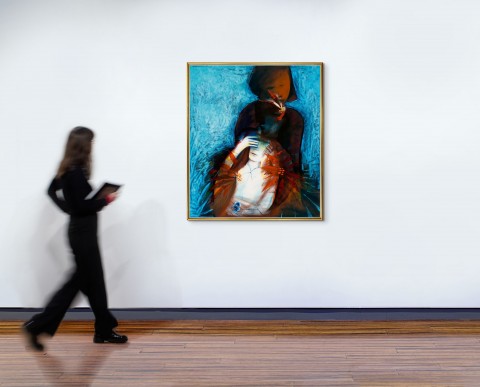HIDE AND SEEK, 1985
CHARLES BLACKMAN
oil and pastel on paper
130.0 x 112.0 cm (sight)
signed and dated upper left: BLACKMAN 85
bears inscription on gallery label verso: CHARLES BLACKMAN / HIDE AND SEEK
Wagner Gallery, Sydney (label attached verso)
Private collection
Christies, Melbourne, 27 August 1997, lot 8
Henry Krongold, Melbourne
The Estate of Paul Krongold, Melbourne
In the early 1950s, Charles Blackman formed a distinctive expressionist style using poetic figurative imagery exploring the innocence and interior worlds of children. The environmental circumstances fuelling the development of this motif are well documented: proximity to schools in the artist’s local suburb, his first wife Barbara’s professional interest in childhood psychology, and a honing of the artist’s skills in observation and recollection to support Barbara in her failing eyesight.1 While Blackman’s resulting ‘Schoolgirl’ series became a distinct suite of works, the themes of play and childhood interaction remained a constant wellspring of inspiration for the artist throughout the rest of his extensive artistic career. Painted in 1985, stark and gestural Hide and Seek, 1985 presents an amalgam of the artist’s most cherished iconographic motifs, imbued with a tropical palette inspired by the lush hinterlands of Buderim, Queensland where the artist was living with his second wife, Genevieve de Couvreur.
In the foreground of Hide and Seek an illuminated pale figure dressed in a uniform shields their eyes, her pensive expression betraying the concentration required for counting. Behind her is hiding a shadowy companion, with an anonymous face, emerging and retreating from the warm umber gloom and foliage in the centre of the painting. The double image is a recurrent device in Blackman’s art, evoked here with a central figure clear and spot lit, while the other is reduced to a nebulous dark silhouette. Painted with a restrained colour palette, Blackman plays with the notion of illumination and discovery, building up an encroaching gestural lightness in the background which threatens to reveal the hidden figure. Felicity St John Moore suggests that the dreamlike contrasts in Blackman’s works were inspired by the works of French symbolist painter Odilon Redon, ‘a duality of dark and light, fantasy and fact, inside and outside, nightmare and drama, harshness and beauty, mysterious expression and pure plastic substance. This duality is internal as well as thematic… the imagery is enigmatic and multilayered.’2
While these figures are intertwined in the group act of play, they do not share any eye contact, they are retreated into interior and solitary worlds of imagination, a metaphor for Blackman’s own artistic pursuits. ‘Here is a man who has dared to paint the unpaintable, the world of dreams, emotions and ideas… he can take our hauntings, the invisible world of hopes and fears, and give them a form and a substance’, wrote friend of the artist, Nadine Amadio in 1993.3
Blackman’s art explores emotion rather than a representation of physical reality. Seeking the poetic in hazy twilight zones, his dreamlike compositions are unfettered by rational space and the laws of the natural world. In Hide and Seek, Blackman indulges in a sensuous interplay of painted textures, toying with notions of opacity and translucency, between velvety richness of shadowed silhouettes and surprising translucent fireworks of scarlet poinsettias. Caught in their own collective world of play, and further fractured into separate, unknowable, interior worlds, these children are vulnerable and exposed to the outside world. We are voyeurs into their private game and like the central figure, our seeking is yet to provide answers.
1. Morgan, K., Charles Blackman Schoolgirls, Heide Museum of Modern Art, Melbourne, 2017, p. 13
2. St John Moore, F., Charles Blackman, Schoolgirls and Angels, National Gallery of Victoria, Melbourne, 1993, pp. 2 – 3
3. Amadio, N., ‘Charles Blackman. A Retrospective Portrait’, Ita Magazine, Sydney, June 1993, p. 39
LUCIE REEVES-SMITH


